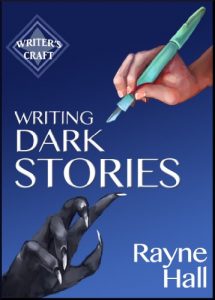Learn to haunt your readers with powerful, chilling tales. Make their spines tingle with anticipation and their skins crawl with delicious fear. Disturb their world-view and invite them to look into the dark corners of their own souls.
This book gives you a wealth of tools and techniques for writing great short stories. It is part of the acclaimed Writer's Craft series.
TABLE OF CONTENTS
Introduction
1. FEED YOUR FICTION WITH YOUR FEARS
Places. Weird Shudders. Phobias. Childhood Fears. Dreams. Human Attitudes. Ordinary Things.
Assignment.
2. WHY THE TITLE IS A STRONG START
Gathering Ideas. Assignment.
3. WRITING BY THE SEAT OF YOUR PANTS
Now Write. Prompts. The Freewriting Experience. Assignment.
4. FIFTEEN MASTER PLOTS
Plot Ideas You Can Use. Assignment.
5. DARK FICTION AND HORROR GENRES
Horror. Splatterpunk. Extreme Horror. Psychological Horror. Dystopian. Lovecraftian. Thriller.
Mystery. Dark Fiction. Supernatural. Paranormal. Paranormal Romance. Dark Fantasy. Urban
Fantasy. Gothic. Erotic Horror. Horror Comedy. Romantic Suspense. Steampunk. Ghost Stories.
Slipstream. Speculative Fiction. Weird Fiction. Flash Fiction. Slice-of-Life. Cross-Genre.
Collection. Anthology. Assignment.
6. POINT OF VIEW
Deep PoV Techniques. Serial Point of View. Omniscient Point of View. Other Point of View Styles.
Assignment.
7. MANAGING TENSION
Goal. Raising the Stakes. Conflicts Among Characters. Peaks and Troughs. Assignment.
8. BUILDING SUSPENSE
Pose a Question. The Ticking Clock. Pacing. The Door Opens. Assignment.
9. HOW TO SCARE YOUR READERS
Darkness. Sounds. Chill. Isolation. Meet the Monster. Get Visceral. The Gory Bits. Assignment.
10. CREEPY LOCATIONS
Select the Setting. Inspiring Pictures. How to Describe the Setting. Practical Research. Setting
Research Checklist. Assignment.
11. MAKE THE MOST OF THE WEATHER
Create Atmosphere. Deepen the PoV. Make it Difficult for the Characters. Strained Tempers. Mood
and Foreboding. Beware the Pathetic Fallacy. Collecting Descriptions. Assignment.
12. HOW TO OPEN YOUR STORY
Opening with Setting Description. Opening with Dialogue. Opening While All Seems Well with the
World. Assignment.
13. HOW TO END YOUR STORY
Endings to Avoid. Seven Possible Endings. Leave Questions in the Reader’s Mind. Assignment.
14. VILLAINS AND MONSTERS
Human Villains: Clichés to Avoid. Motivation. Depth. Describing the Villain. Monsters: Reveal it
Bit by Bit. Keep it Plausible. Assignment.
15. GHOST STORIES
Plot and Backstory. Setting and Mood. Characters and Point of View. Assignment.
16. VAMPIRES, WEREWOLVES, ZOMBIES
Vampires: Sparkling Versus Traditional. Vampire Tropes. Fiction Ideas. Werewolves: Werewolf
Tropes. Questions to Consider. Zombies: How Zombies are Made. Zombie Tropes. Fiction Ideas.
Beware the Bite-Hiders. Assignment.
17. RELIGIOUS HORROR
Horror in Holy Books. Faith Versus Fear. Religious Historical Horror. Unbelievers Meet Scary
Gods. Stories Presenting Religion as Evil. Writing About Other Faiths. Controversy. Assignment.
18. Why Do People Read Horror Fiction?
Seven Psychological Reasons. Assignment.
19. MARKETING AND PUBLICATION
Traditional Publishing. Markets. Rights. Payment. Self-Publishing. Trends. Assignments.
20. SAMPLE STORIES WITH COMMENTS
Burning. Seagulls. Only A Fool.
DEAR READER
This book uses British English.
This book gives you a wealth of tools and techniques for writing great short stories. It is part of the acclaimed Writer's Craft series.
TABLE OF CONTENTS
Introduction
1. FEED YOUR FICTION WITH YOUR FEARS
Places. Weird Shudders. Phobias. Childhood Fears. Dreams. Human Attitudes. Ordinary Things.
Assignment.
2. WHY THE TITLE IS A STRONG START
Gathering Ideas. Assignment.
3. WRITING BY THE SEAT OF YOUR PANTS
Now Write. Prompts. The Freewriting Experience. Assignment.
4. FIFTEEN MASTER PLOTS
Plot Ideas You Can Use. Assignment.
5. DARK FICTION AND HORROR GENRES
Horror. Splatterpunk. Extreme Horror. Psychological Horror. Dystopian. Lovecraftian. Thriller.
Mystery. Dark Fiction. Supernatural. Paranormal. Paranormal Romance. Dark Fantasy. Urban
Fantasy. Gothic. Erotic Horror. Horror Comedy. Romantic Suspense. Steampunk. Ghost Stories.
Slipstream. Speculative Fiction. Weird Fiction. Flash Fiction. Slice-of-Life. Cross-Genre.
Collection. Anthology. Assignment.
6. POINT OF VIEW
Deep PoV Techniques. Serial Point of View. Omniscient Point of View. Other Point of View Styles.
Assignment.
7. MANAGING TENSION
Goal. Raising the Stakes. Conflicts Among Characters. Peaks and Troughs. Assignment.
8. BUILDING SUSPENSE
Pose a Question. The Ticking Clock. Pacing. The Door Opens. Assignment.
9. HOW TO SCARE YOUR READERS
Darkness. Sounds. Chill. Isolation. Meet the Monster. Get Visceral. The Gory Bits. Assignment.
10. CREEPY LOCATIONS
Select the Setting. Inspiring Pictures. How to Describe the Setting. Practical Research. Setting
Research Checklist. Assignment.
11. MAKE THE MOST OF THE WEATHER
Create Atmosphere. Deepen the PoV. Make it Difficult for the Characters. Strained Tempers. Mood
and Foreboding. Beware the Pathetic Fallacy. Collecting Descriptions. Assignment.
12. HOW TO OPEN YOUR STORY
Opening with Setting Description. Opening with Dialogue. Opening While All Seems Well with the
World. Assignment.
13. HOW TO END YOUR STORY
Endings to Avoid. Seven Possible Endings. Leave Questions in the Reader’s Mind. Assignment.
14. VILLAINS AND MONSTERS
Human Villains: Clichés to Avoid. Motivation. Depth. Describing the Villain. Monsters: Reveal it
Bit by Bit. Keep it Plausible. Assignment.
15. GHOST STORIES
Plot and Backstory. Setting and Mood. Characters and Point of View. Assignment.
16. VAMPIRES, WEREWOLVES, ZOMBIES
Vampires: Sparkling Versus Traditional. Vampire Tropes. Fiction Ideas. Werewolves: Werewolf
Tropes. Questions to Consider. Zombies: How Zombies are Made. Zombie Tropes. Fiction Ideas.
Beware the Bite-Hiders. Assignment.
17. RELIGIOUS HORROR
Horror in Holy Books. Faith Versus Fear. Religious Historical Horror. Unbelievers Meet Scary
Gods. Stories Presenting Religion as Evil. Writing About Other Faiths. Controversy. Assignment.
18. Why Do People Read Horror Fiction?
Seven Psychological Reasons. Assignment.
19. MARKETING AND PUBLICATION
Traditional Publishing. Markets. Rights. Payment. Self-Publishing. Trends. Assignments.
20. SAMPLE STORIES WITH COMMENTS
Burning. Seagulls. Only A Fool.
DEAR READER
This book uses British English.






